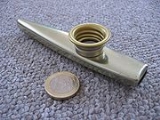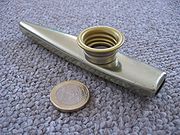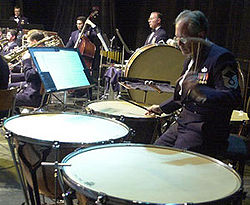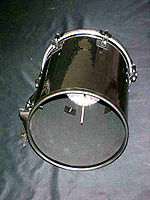
Membranophone
Encyclopedia
A membranophone is any musical instrument
which produces sound
primarily by way of a vibrating stretched membrane. It is one of the four main divisions of instruments in the original Hornbostel-Sachs
scheme of musical instrument classification
.
Most membranophones are drum
s. Hornbostel-Sachs divides drums into three main types: struck drums, where the skin is hit with a stick, the hand, or something else; string drums, where a knotted string attached to the skin is pulled, passing its vibrations onto the skin; and friction drums, where some sort of rubbing motion causes the skin to vibrate (a common type has a stick passing through a hole in the skin which is pulled back and forth).
In addition to drums, there is another kind of membranophone, called the singing membranophone, of which the best known type is the kazoo
. These instruments modify a sound produced by something else, commonly the human voice, by having a skin vibrate in sympathy with it.
scheme of musical instrument classification
divides membranophones in a numeric taxonomy based on how the sound is produced:

SIL International
maintains a classification system based largely on shape:


Traditional Japanese and Korean instrument classification schemes use essentially the same scheme.
The traditional classification of Indian instruments include two categories of membranophones.
.
Water drum
s are also sometimes treated as a distinct category of membranophone. Common in Native American music
and the music of Africa
, water drums are characterized by a unique sound caused by filling the drum with some amount of water.
The talking drum is an important category of West African membranophone, characterized by the use of varying tones to "talk". Talking drums are used to communicate across distances.
Musical instrument
A musical instrument is a device created or adapted for the purpose of making musical sounds. In principle, any object that produces sound can serve as a musical instrument—it is through purpose that the object becomes a musical instrument. The history of musical instruments dates back to the...
which produces sound
Sound
Sound is a mechanical wave that is an oscillation of pressure transmitted through a solid, liquid, or gas, composed of frequencies within the range of hearing and of a level sufficiently strong to be heard, or the sensation stimulated in organs of hearing by such vibrations.-Propagation of...
primarily by way of a vibrating stretched membrane. It is one of the four main divisions of instruments in the original Hornbostel-Sachs
Hornbostel-Sachs
Hornbostel–Sachs is a system of musical instrument classification devised by Erich Moritz von Hornbostel and Curt Sachs, and first published in the Zeitschrift für Ethnologie in 1914. An English translation was published in the Galpin Society Journal in 1961...
scheme of musical instrument classification
Musical instrument classification
At various times, and in various cultures, various schemes of musical instrument classification have been used.The most commonly used system in use in the west today divides instruments into string instruments, wind instruments and percussion instruments...
.
Most membranophones are drum
Drum
The drum is a member of the percussion group of musical instruments, which is technically classified as the membranophones. Drums consist of at least one membrane, called a drumhead or drum skin, that is stretched over a shell and struck, either directly with the player's hands, or with a...
s. Hornbostel-Sachs divides drums into three main types: struck drums, where the skin is hit with a stick, the hand, or something else; string drums, where a knotted string attached to the skin is pulled, passing its vibrations onto the skin; and friction drums, where some sort of rubbing motion causes the skin to vibrate (a common type has a stick passing through a hole in the skin which is pulled back and forth).
In addition to drums, there is another kind of membranophone, called the singing membranophone, of which the best known type is the kazoo
Kazoo
The kazoo is a wind instrument which adds a "buzzing" timbral quality to a player's voice when the player vocalizes into it. The kazoo is a type of mirliton, which is a membranophone, a device which modifies the sound of a person's voice by way of a vibrating membrane."Kazoo" was the name given by...
. These instruments modify a sound produced by something else, commonly the human voice, by having a skin vibrate in sympathy with it.
Hornbostel-Sachs
The Hornbostel-SachsHornbostel-Sachs
Hornbostel–Sachs is a system of musical instrument classification devised by Erich Moritz von Hornbostel and Curt Sachs, and first published in the Zeitschrift für Ethnologie in 1914. An English translation was published in the Galpin Society Journal in 1961...
scheme of musical instrument classification
Musical instrument classification
At various times, and in various cultures, various schemes of musical instrument classification have been used.The most commonly used system in use in the west today divides instruments into string instruments, wind instruments and percussion instruments...
divides membranophones in a numeric taxonomy based on how the sound is produced:
- 21: by hitting the drumskin with a hand or object (most common form, including the timpaniTimpaniTimpani, or kettledrums, are musical instruments in the percussion family. A type of drum, they consist of a skin called a head stretched over a large bowl traditionally made of copper. They are played by striking the head with a specialized drum stick called a timpani stick or timpani mallet...
and snare drumSnare drumThe snare drum or side drum is a melodic percussion instrument with strands of snares made of curled metal wire, metal cable, plastic cable, or gut cords stretched across the drumhead, typically the bottom. Pipe and tabor and some military snare drums often have a second set of snares on the bottom...
) - 22: by pulling a knotted string attached to the drumskin (common in Indian drums, and can be considered an example of a chordophoneChordophoneA chordophone is any musical instrument that makes sound by way of a vibrating string or strings stretched between two points. It is one of the four main divisions of instruments in the original Hornbostel-Sachs scheme of musical instrument classification....
as well) - 23: by rubbing the drumskin with a hand or object (common in irish traditional music, an example is the bodhranBodhránThe bodhrán is an Irish frame drum ranging from 25 to 65 cm in diameter, with most drums measuring 35 to 45 cm . The sides of the drum are 9 to 20 cm deep. A goatskin head is tacked to one side...
) - 24: by modifying sounds through a vibrating membrane (unusual form, including the kazooKazooThe kazoo is a wind instrument which adds a "buzzing" timbral quality to a player's voice when the player vocalizes into it. The kazoo is a type of mirliton, which is a membranophone, a device which modifies the sound of a person's voice by way of a vibrating membrane."Kazoo" was the name given by...
)
Shape and technique
Membranophones can also be divided into large divisions based on shape and manner of sound production:
- Tubular drums include a wide range of drum shapes, like waisted, long, footed, cylindrical, conical and barrel
- Kettle drums and vessel drums are characterized by the presence of rounded bottoms.
- Frame drums consist of a membrane stretched across a frame.
- Friction drums produce sound by rubbing a stick through a hole in a membrane stretched across a frame.
- Mirlitons and kazoos vibrate by blowing air across a membrane. These are the only membranophones that are not truly drums.
SIL International
SIL International
SIL International is a U.S.-based, worldwide, Christian non-profit organization, whose main purpose is to study, develop and document languages, especially those that are lesser-known, in order to expand linguistic knowledge, promote literacy, translate the Christian Bible into local languages,...
maintains a classification system based largely on shape:
- Cylindrical drumCylindrical drumCylindrical drums are a category of drum instruments that include a wide range of implementations, including the bass drum and the Iranian dohol. Cylindrical drums are generally two-headed and straight-sided, and sometimes use a buzzing, percussive string....
s are straight-sided, and generally two-headed. A buzzing, percussive string is sometimes used. Examples include the bass drumBass drumBass drums are percussion instruments that can vary in size and are used in several musical genres. Three major types of bass drums can be distinguished. The type usually seen or heard in orchestral, ensemble or concert band music is the orchestral, or concert bass drum . It is the largest drum of...
and the Iranian dohol. - Conical drumConical drumConical drums are a class of membranophone, or drum, that is characterized by sloping sides. They are usually one-headed. An example is the timbal....
s are sloped on the sides, and are usually one-headed. Examples include the Indian tablaTablaThe tabla is a popular Indian percussion instrument used in Hindustani classical music and in popular and devotional music of the Indian subcontinent. The instrument consists of a pair of hand drums of contrasting sizes and timbres...
and the Venezuelan chimbangueles.


- Barrel drumBarrel drumBarrel drums are a class of membranophone, or drum, characterized by a barrel-shape with a bulge in the middle. They are often one-headed and open at the bottom...
s are normally one-headed, and may be open at the bottom. They bulge in the middle. Examples include the bendre, made by the Mossi of Burkina Faso out of a large calabashCalabashLagenaria siceraria , bottle gourd, opo squash or long melon is a vine grown for its fruit, which can either be harvested young and used as a vegetable, or harvested mature, dried, and used as a bottle, utensil, or pipe. For this reason, the calabash is widely known as the bottle gourd...
, and the trong chau of Vietnam. - Hourglass drumHourglass drumHourglass drums are a sub-category of membranophone, or drum, characterized by an hourglass shape. They are also known as waisted drums...
s (or waisted drums) are hourglassHourglassAn hourglass measures the passage of a few minutes or an hour of time. It has two connected vertical glass bulbs allowing a regulated trickle of material from the top to the bottom. Once the top bulb is empty, it can be inverted to begin timing again. The name hourglass comes from historically...
-shaped and generally two-headed. The drumheads are laced onto the body, and the laces may be squeezed during performance to alter the drum's pitch. Examples include folk drums in India (like the damaruDamaruA damaru or damru is a small two-headed drum shaped like an hourglass. The drum is typically made of wood, with leather drum heads at both ends; the damaru might also be made entirely out of human skulls...
) and much of Africa, as well as some talking drums. - Goblet drumGoblet drumThe goblet drum is a hand drum with a goblet shape used mostly in the Middle East, North Africa, and Eastern Europe....
s (or chalice drums) are one-headed and goblet shaped, and are usually open at the bottom. Examples include the Arab darabukka, and a range of similar instruments from Armenia, Azerbaijan, North Africa, Southeastern Europe and the Middle East. - Footed drumFooted drumFor another term, see foot drumA footed drum is a class of membranophone, of native american and polynesian origin, characterized by an open area at the bottom of the instrument, held by feet...
s are single-headed and are held above the ground by feet. The space between the drum and the ground provides extra resonance. Examples include a range of East African and Polynesian drums. - Long drumLong drumLong drums are a loose category of tubular membranophones, characterized by their extreme length. They are most common in Africa, Thailand, and in Native American traditions. Long drums can be made out of entire tree trunks....
s are a diverse category, characterized by extreme length. Examples include the single-headed hollow tree trunk drums of Africa and the ornately carved and dyed gufalo of the Nuna in Burkina Faso. - Kettle drums (or pot drums or vessel drums) are frequently played in pairs, and have a vessel or pot body, are one-headed and usually tuned to a specific note. Examples include the timpaniTimpaniTimpani, or kettledrums, are musical instruments in the percussion family. A type of drum, they consist of a skin called a head stretched over a large bowl traditionally made of copper. They are played by striking the head with a specialized drum stick called a timpani stick or timpani mallet...
and tablaTablaThe tabla is a popular Indian percussion instrument used in Hindustani classical music and in popular and devotional music of the Indian subcontinent. The instrument consists of a pair of hand drums of contrasting sizes and timbres...
. - Frame drumFrame drumA frame drum is a drum that has a drumhead width greater than its depth. Usually the single drumhead is made of rawhide or man-made materials. Shells are traditionally constructed of bent wood scarf jointed together; plywood and man-made materials are also used. Some frame drums have mechanical...
s are composed of one or more membranes stretched across a frame. Examples include the tambourineTambourineThe tambourine or marine is a musical instrument of the percussion family consisting of a frame, often of wood or plastic, with pairs of small metal jingles, called "zils". Classically the term tambourine denotes an instrument with a drumhead, though some variants may not have a head at all....
and bodhranBodhránThe bodhrán is an Irish frame drum ranging from 25 to 65 cm in diameter, with most drums measuring 35 to 45 cm . The sides of the drum are 9 to 20 cm deep. A goatskin head is tacked to one side...
. - Friction drumFriction drumHornbostel-Sachs classification number 232.11-92A friction drum is a musical instrument found in various forms in Africa, Asia, Europe and South America...
s produce sound through frictionFrictionFriction is the force resisting the relative motion of solid surfaces, fluid layers, and/or material elements sliding against each other. There are several types of friction:...
, such as by rubbing a hand or object against the drumskin. Examples include the Brazilian cuicaCuícaCuíca , or "kweeca", is a Brazilian friction drum often used in samba music. The tone it produces has a high-pitched squeaky timbre. It has been called a 'laughing gourd' due to this sound....
and the Spanish zambomba. - MirlitonMirlitonMirliton may refer to:*Chayote or mirliton, a pear-shaped vegetable or its vine*Mirliton , a comic book cat character created by Raymond Macherot and Raoul Cauvin*Mirliton, a type of membranophone...
s and kazooKazooThe kazoo is a wind instrument which adds a "buzzing" timbral quality to a player's voice when the player vocalizes into it. The kazoo is a type of mirliton, which is a membranophone, a device which modifies the sound of a person's voice by way of a vibrating membrane."Kazoo" was the name given by...
s produce sound by blowing air across a membrane.
Traditional classifications
The traditional Chinese method of classifying instruments by composite material renders the following categories of drums:- Jin: Metal drums, along with bells and gongs
- Ge: Leather-headed drums
- Mu: Wood drums and blocks
- Tu: Clay drums, as well as some kinds of clay ocarinaOcarinaThe ocarina is an ancient flute-like wind instrument. Variations do exist, but a typical ocarina is an enclosed space with four to twelve finger holes and a mouthpiece that projects from the body...
s
Traditional Japanese and Korean instrument classification schemes use essentially the same scheme.
The traditional classification of Indian instruments include two categories of membranophones.
- Ghan: Percussion without membranes, such as chimes, bells and gongs
- Avanaddh: Percussion with membranes, such as drums with skin heads
Other categories
The predrum category consists of simple drum-like percussion instruments. These include the ground drum, which, in its most common form, consists of an animal skin stretched over a hole in the ground, and the pot drum, made from a simple potPot
Pot commonly refers to pottery, the ceramic ware made by pottersPot may also refer to:- Containers :* Plant pot or flower pot, a container in which plants are cultivated* Cooking pot, a stove-top cooking utensil* Chamber pot, a bedside urinal...
.
Water drum
Water drum
Water drums are a category of membranophone characterized by the filling of the drum chamber with some amount of water to create a unique sound. Water drums are common in Native American music, and in some forms of African and Southeast Asian music....
s are also sometimes treated as a distinct category of membranophone. Common in Native American music
Native American music
American Indian music is the music that is used, created or performed by Native North Americans, specifically traditional tribal music. In addition to the traditional music of the Native American groups, there now exist pan-tribal and inter-tribal genres as well as distinct Indian subgenres of...
and the music of Africa
Music of Africa
Africa is a vast continent and its regions and nations have distinct musical traditions. The music of North Africa for the most part has a different history from sub-Saharan African music traditions....
, water drums are characterized by a unique sound caused by filling the drum with some amount of water.
The talking drum is an important category of West African membranophone, characterized by the use of varying tones to "talk". Talking drums are used to communicate across distances.

